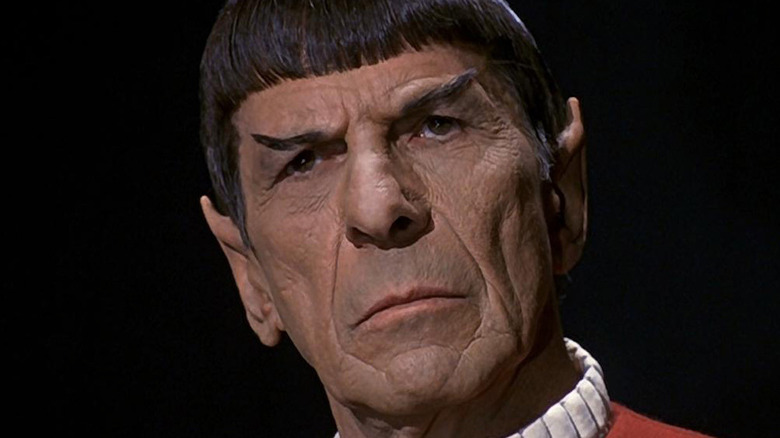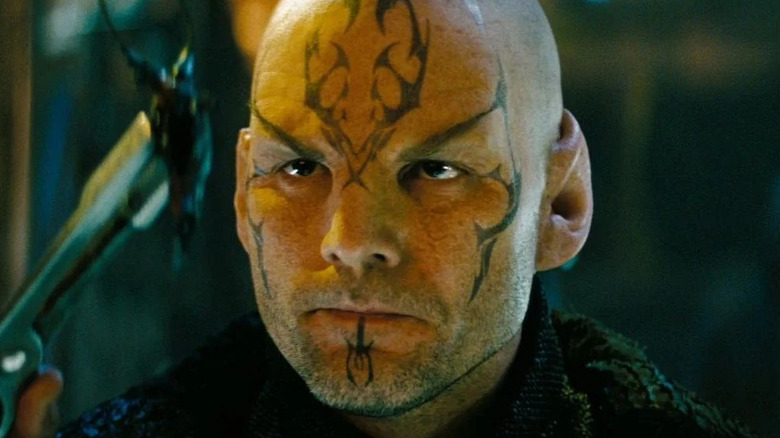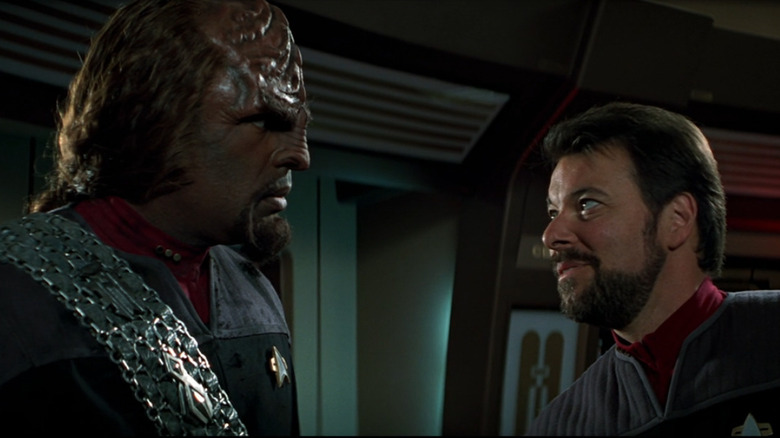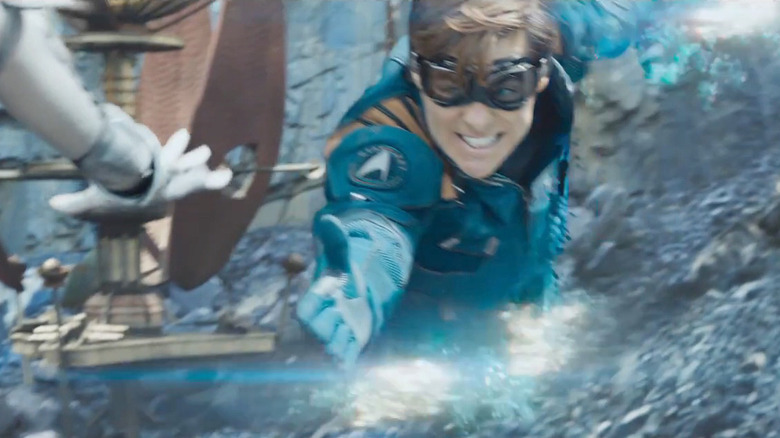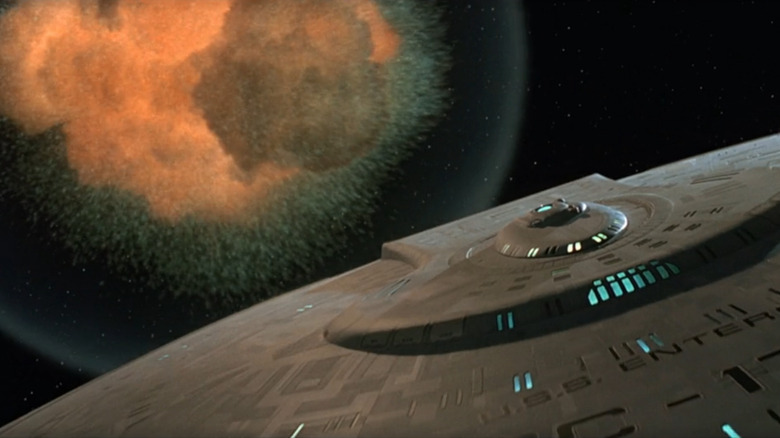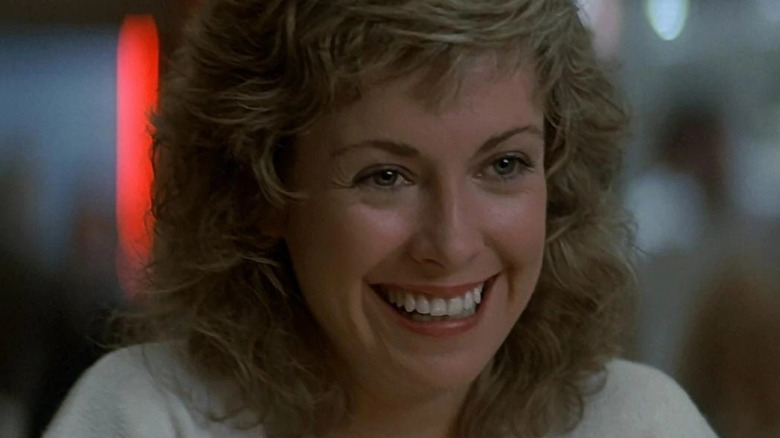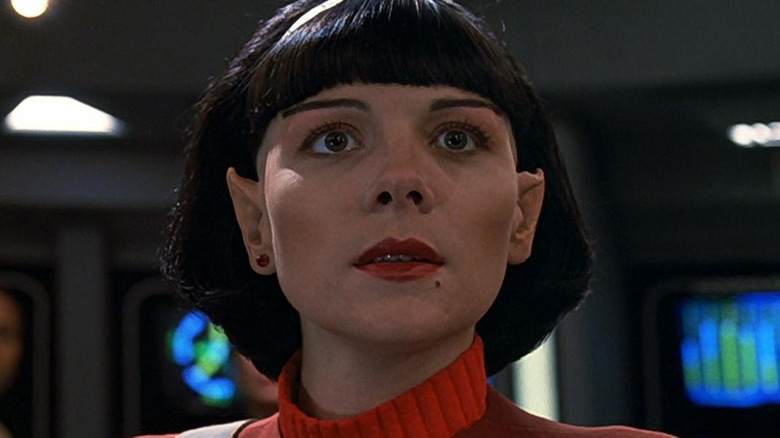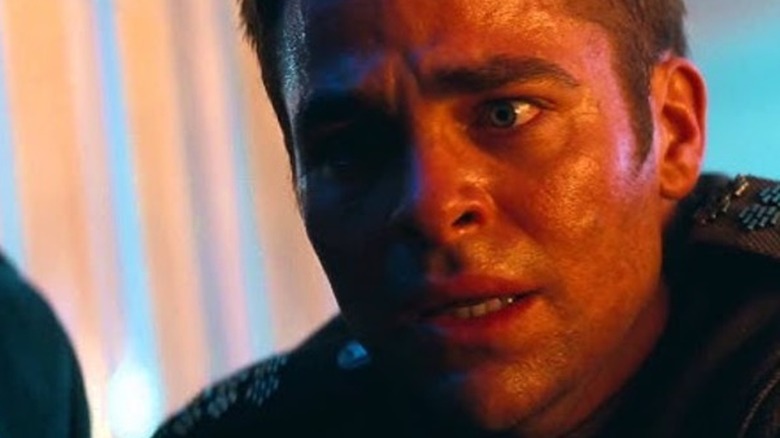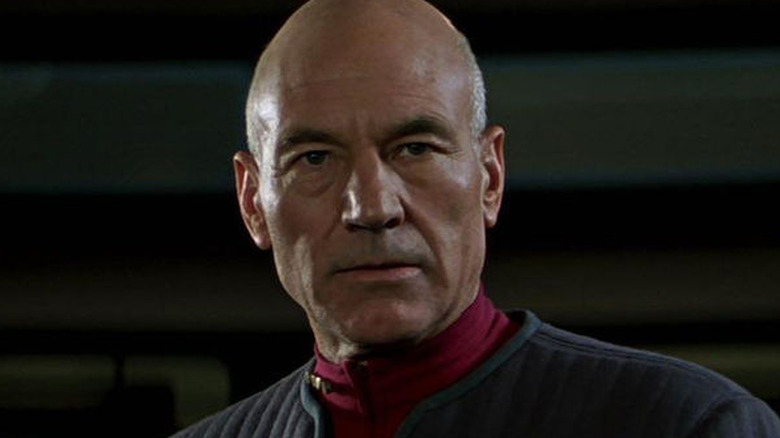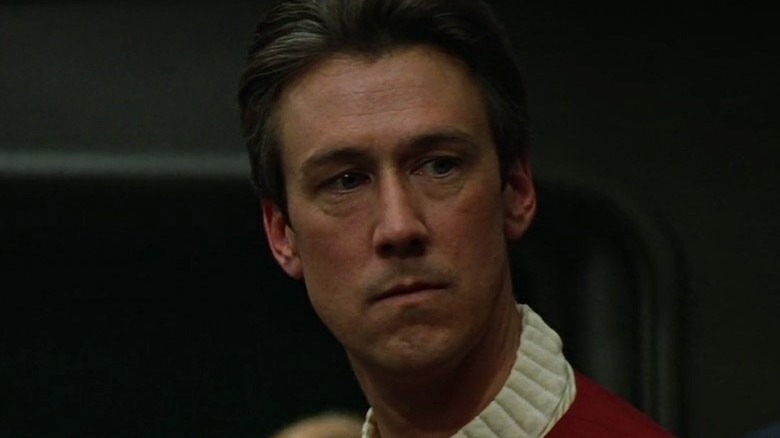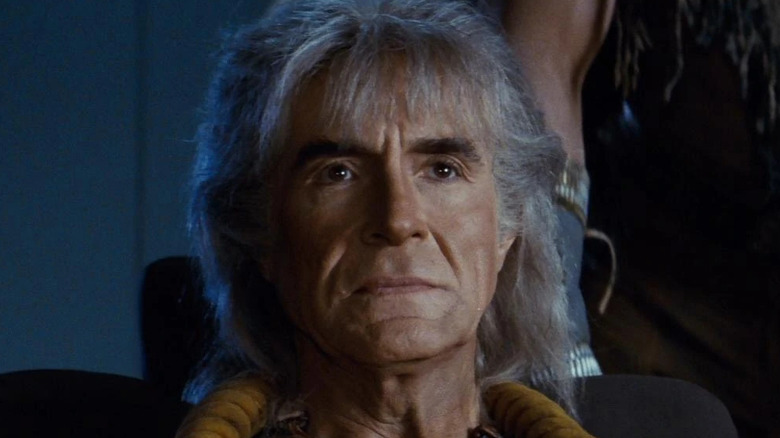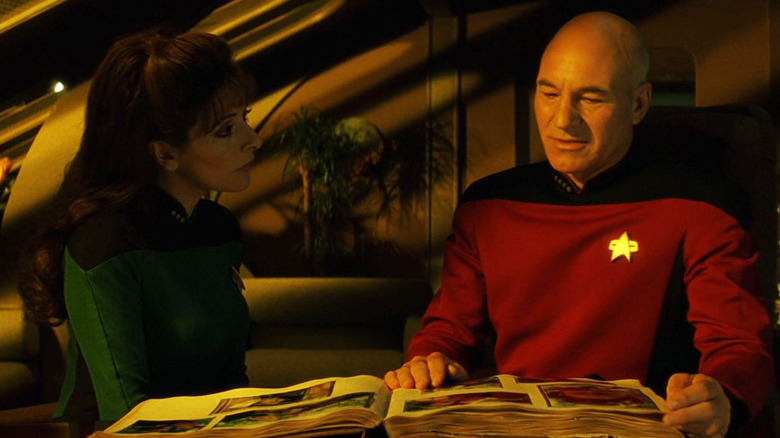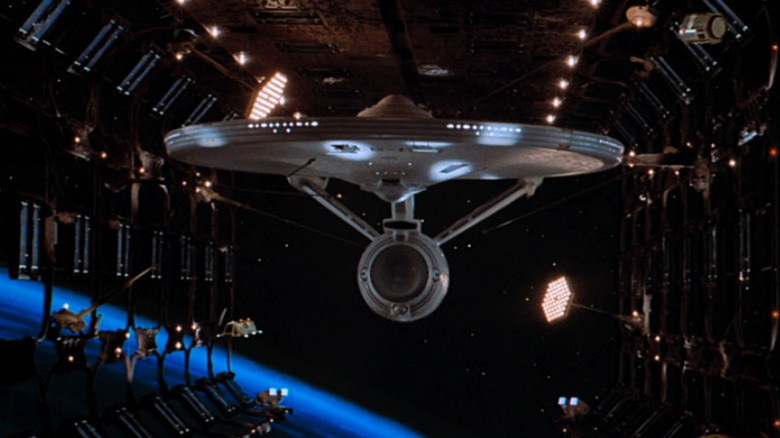Things That Happen In Every Star Trek Movie
When it first launched on television in 1966, few could have possibly imagined "Star Trek" lasting so many more decades, let alone continuing across a variety of spin-off series. Even fewer probably could have foreseen that the little sci-fi show from the mind of Gene Roddenbery would make the jump to the big screen, where for more than three decades it would dazzle audiences around the world with outer space adventures.
With each new episode, decade after decade, "Star Trek" has continued to explore strange new worlds and boldly go where no one has gone before. No matter what century the stories are set in, and whether aboard a starship, a space station, or focused on a single iconic character like Jean-Luc Picard, there are some elements so intrinsic to "Trek" that they show up nearly every time. And just as every "Star Trek" TV series has its shared hallmarks, so too do the feature films have their own commonalities — elements that recur across more than a dozen films, three crews, and parts of five decades.
From William Shatner and Patrick Stewart to Chris Pine, and from baddies to beauty shots, we've found a number of things that the talented folks behind the "Star Trek" movies have almost always included. So charge your phasers and prepare to go to warp: Here's a list of all the things you can find in just about every "Star Trek" movie.
A villain that threatens millions
If a big-budget action movie doesn't have a major villain at its center — killing hundreds of people, threatening thousands more, or even seeking global domination — it might seem incomplete. In a space adventure like "Star Wars," you might even be confused if there were no enemy putting entire worlds at risk. But in "Star Trek," things have always worked a little differently. Across more than 60 years of television, most episodes didn't have a big bad or world-ending threat. Sure, you'd have the big finale here or there with the Borg or a storyline with a major threat like the Dominion, but some of the best "Trek" stories don't have a traditional villain.
When it comes to the movies, however, it seems that the writers and producers always want to go bigger — even as far back as "Star Trek: The Motion Picture" in 1979, where a mysterious craft threatens to destroy planet Earth. Since then, it's never stopped. We've had renegade Klingons attempting to use Genesis as a world-ending weapon ("Star Trek III: The Search for Spock"), an alien probe that nearly wiped out Earth ("Star Trek IV: The Voyage Home), and several vengeful interstellar tyrants, at least two of which destroyed entire planets ("Star Trek Generations" and J.J. Abrams' first reboot). Somehow, every movie seems to have a threat of galactic scale that the Enterprise has to stop. This trend may not have always been wholly consistent with the stories from the TV series, but there's no denying that the bigger, bolder villains make sense for the franchise's big-screen outings.
Jokes on the stick-in-the-mud
Since it first hit the airwaves, every "Star Trek" series has had many of the same hallmarks: A bold commander, an intrepid crew, and missions that bring them to strange new worlds. But interestingly, every series has also had at least one stick-in-the-mud character — a straight-laced, mostly humorless, by-the-book officer who always becomes the butt of everyone's jokes. "The Original Series" has Spock being endlessly teased by McCoy, while "The Next Generation" has the android Data on the receiving end of plenty of laughs. "Deep Space Nine" has the grumpy Constable Odo, while "Voyager" uses the Doctor as both the giver and receiver of comedy due to his uptight nature and sarcastic charm.
When "Star Trek" has gone to the silver screen, filmmakers have made sure to take that tradition with them. Since 1979, every movie in the series has made sure to include wisecracks at the expense of one of those uptight characters. In the original six feature films starring Captain Kirk, it's Spock once again, while Data and Worf are each made butt of the jokes in the four "TNG" films.
With the rebooted "Star Trek" in 2009 delivering three new feature films, the custom continued. J.J. Abrams was sure to include the trademark humor directed at Mr. Spock, this time played by Zachary Quinto. Sometimes it was Karl Urban's Dr. McCoy razzing the green-blooded Vulcan, others it was Kirk himself, and on at least a couple of occasions it was even Nyoto Uhura (Zoe Saldana).
The transporter rescue
Arguably the most iconic piece of fictional technology in "Star Trek," the transporter was actually created for the original TV series simply as a way of cutting costs by avoiding travel scenes for the crew (via Comic Book Resources). In the many episodes that followed, it became a handy tool and even a major plot device itself in some episodes, as accidents involving the transporter have caused more than a few problems.
When it comes to the films, the transporter is used in even more dramatic ways. In most of the "Star Trek" movies, there's a scene where a quick beam-up saves the day just in the nick of time. For instance, in "Star Trek IV: The Voyage Home," Scotty beams Chekov, Kirk, McCoy, and Dr. Taylor up to the ship just as they're about to be discovered by 20th-century police. Worf is beamed off the Defiant moments before it loses life support in "First Contact," and Picard is beamed out of a deadly encounter with the villain Ruafo in "Insurrection" just seconds before the whole ship he's on self-destructs. In the J.J. Abrams "Star Trek" films, the teleporter is used to maximum effect, saving Kirk's life in mid-air more than once. Though it's rarely used so dramatically in the television series, the transporter is the perfect way to give audiences suspenseful, death-defying action sequences in the "Star Trek" movies.
The Enterprise is nearly destroyed
One of the many criticisms leveled at J.J. Abrams' "Star Trek" films is that they're too action-heavy. One could certainly make the case that the Enterprise is too often on the receiving end of big alien attacks in the movies — an undignified look for such a noble and majestic vessel. But to be fair, if "Star Trek" films have made anything a tradition, it's having the Enterprise get the living daylights knocked out of it.
Perhaps some filmmakers have done it to show how powerful of a threat the crew is facing, or maybe it's just a simple but effective way of raising the stakes. But as far back as the early 1980s, the Enterprise has received constant poundings. It's pummeled by Khan in "Star Trek II: The Wrath of Khan," leaving it in need of serious repairs at the start of the next film. It's promptly blown up in "Star Trek III" following a battle with the Klingon Kruge, and in "Star Trek VI," the ship gets blasted by General Chang, who nearly blows it out of the stars.
Moving into the "Next Generation" films, the Enterprise-D is destroyed in "Generations," again by Klingons, and the Borg do a number on the Enterprise-E in "First Contact." The Romulans and Son'a each have a serious run at the ship in "Insurrection" and "Nemesis" too. Suffice it to say, the Enterprise has been a punching bag for decades, and filmmakers seem to love running the iconic starship through the wringer. In reality, Abrams' treatment of the vessel is nothing new at all.
An unexpected ally
In addition to seeking out new life and new civilizations episode after episode, one cornerstone of "Star Trek" throughout its long history on television has been the guest star of the week. Whether it's a big-name actor stopping in for a cameo or just a new character joining the crew for an episode, these walk-ons have always been staples of the franchise. It might be a fellow Starfleet officer joining from another ship or an alien who helps the crew in their mission, but either way, the movies take the idea and run with it. That's why a new character pops up in every movie and joins the cast, becoming an unexpected ally in their adventure. Even more than in the TV shows, adding a new face to the mix helps mix things up for the crew of the Enterprise.
In the films in particular, these new friends often come from unexpected places, sometimes even being introduced as potential foils to Kirk or Picard. David Marcus serves this role in "The Wrath of Khan" and "The Search For Spock," while Kirk himself becomes the unexpected ally in "Star Trek Generations." This role has often gone to women on the big screen, like with Lt. Saavik in "The Search for Spock," Dr. Gillian Taylor in "The Voyage Home," and Lily in "First Contact." From Ilia to Jaylah, whenever the Enterprise needs help, there's usually a strong woman stepping up to lend a helping hand.
An unexpected enemy
If there's anything "Star Trek" movies love more than a new ally coming from a surprising place, it's a new enemy coming from a surprising place. It may not always be the main villain — normally the mustache-twirling type you can see from a mile away (Khan, Nero, Shinzon, Kruge, etc.) — but there's usually a supporting bad guy of some kind who's a little bit harder to spot.
Arguably the most notable instance of this is in "Star Trek VI: The Undiscovered Country" when it's revealed that Lt. Valeris, the ship's new resident Vulcan, is actually a traitor. But Valeris is by no means alone. The main adversary of "Star Trek: The Motion Picture" turns out to be Earth's own space probe, while the U.S. Army becomes the enemy in "Star Trek IV: The Voyage Home." Spock's own brother is the baddie in "The Final Frontier," and there's nothing more surprising than learning that Starfleet Admiral Dougherty is behind the villainous plot in "Star Trek: Insurrection" That is, unless you've seen one of the many TV episodes of "Trek" in which an admiral goes bad. Even though "Star Trek" may not be known for major surprise twists or villainous reveals on television, they're trademarks of the franchise's films.
Encounters with death
It makes sense that when "Star Trek" moved to the big screen, the stories had to be bigger, bolder, and with higher stakes. In addition to their big villains and galactic threats, the "Star Trek" movies love killing off major characters, or at least bringing them very close to death. While the franchise has certainly killed off characters on TV as well, it's typically been much rarer, with most casualties being unnamed "redshirts." All that changed at the movies, though, with "Star Trek: The Motion Picture" emphatically letting the audience know that anything could happen with the stunning death of Ilia.
Of course, the most famous "Trek" death of all time occurs at the climax of "The Wrath of Khan" when Spock sacrifices himself for the ship. Kirk's son David is killed in the following film, and Chekov comes very close to dying in "The Voyage Home." The "Next Generation" films aren't afraid to kill either, with Captain Kirk dying in "Generations" and Data biting the dust in "Star Trek: Nemesis." From George Kirk and Captain Robau in the opening moments of 2009's "Star Trek" to Admiral Pike's death in "Into Darkness" and Nimoy's original Spock dying off-screen at the beginning of "Star Trek Beyond," the newer films have also killed off plenty of major characters.
As Captain Kirk himself famously said, "How we deal with death is at least as important as how we deal with life." It would seem the filmmakers of "Star Trek" have taken that to heart, using death to make impactful cinematic statements time and again.
Defying orders from above
For a group of Starfleet officers bound by oath to the organization they serve, it's curious that the Enterprise crew breaks rules and defies orders with such regularity. And yet, the "Star Trek" films often put their captains at odds with the Starfleet bosses, and officers are constantly refusing commands or going rogue. Kirk, who's much more of a by-the-book officer in the original "Star Trek" series, becomes an "insubordinate, unprincipled, career-minded opportunist" in the movies.
Kirk steals the Enterprise to save Spock in "Star Trek III" and violates several Starfleet directives by going back in time in "The Voyage Home." Captain Sulu defies his orders and helps Kirk in "The Undiscovered Country," and Captain Picard goes against Starfleet brass multiple times. He goes to Earth to engage the Borg in "First Contact," and the entirety of "Insurrection" involves Picard breaking every order to do what he feels is right. J.J. Abrams' version of Kirk also goes rogue multiple times, and even Spock gets in on the rule-breaking action in the reboot films.
Despite the TV stories often centering a strict adherence to protocol and obedience to the chain of command, the movies have made it commonplace for crew members, officers, and even captains to defy orders. The TV version of Picard would have winced at the thought of breaking the rules, but in the movies, he's more than happy to butt heads with Starfleet over and over again.
An new or ill-equipped starship
The Enterprise — in each of the three distinct "Star Trek" film series — is usually portrayed as one of the best ships in the flee. It's the most powerful and advanced vessel crewed by the best of the best. As it's Starfleet's flagship — sent on the most critical missions — it stands to reason that you'd want the cream of the crop on the job. That makes it all the more perplexing why in the "Star Trek" movies, the ship is usually poorly equipped or crewed by a team who's not quite ready for the job. This odd trend goes all the way back to the very first "Star Trek" film in 1979, where the Enterprise is sent off to discover the secret of a galactic menace before its refit is even complete.
The sequel, "The Wrath of Khan," does it again, sending the Enterprise off on a mission when it's manned mostly by cadets unready for a conflict. In "Star Trek III," the Enterprise is stolen from a starbase by Kirk, who brings just a skeleton bridge crew with him. And in "Star Trek IV," that same crew is left aboard an ill-equipped Klingon Bird of Prey. The problem doesn't end when the movies leave the original Enterprise behind either, as Captain Harriman's Enterprise-B doesn't have most of its systems when it launches in "Star Trek Generations." The Enterprise is still undergoing a shakedown cruise in "First Contact" when its crew faces the Borg, and the problems continues in the J.J. Abrams films, with the Enterprise repeatedly rushed out into space to tackle a new threat.
Maybe it's for strictly dramatic reasons, but the movies always seem to put Kirk, Picard, and their crews on the back foot from the start.
References to old adventures
If there's any franchise that loves to indulge in continuity and canon, rewarding its audience for decades of loyalty, it's definitely "Star Trek." While the movies are of course designed to be enjoyed by fans both new and old, the writers just can't seem to help themselves from making references to older adventures or previous movies, even when they don't tie directly into the story at hand.
As a sequel to the "Original Series" episode "Space Seed," it made perfect sense to mention the events of that episode in "The Wrath of Khan." In "The Voyage Home," Kirk makes a direct callback to the adventures of "Tomorrow is Yesterday" when he discusses the slingshot time travel method. References are even made to episodes of "Star Trek: The Next Generation" in "The Undiscovered Country" with the appearance of Colonel Worf — the grandfather of future Enterprise security chief Lt. Worf. The "TNG" films make plenty of their own references to past episodes and films, with Data's emotion chip from the episode "Descent" playing a critical role in "Generations" and lots of nods to "The Best of Both Worlds" in the sequel, "First Contact." Even the newer films revel in references to old episodes, with "Star Trek Beyond" being loaded with callbacks to "Star Trek: Enterprise," including a mention of the Xindi War.
While some may view these Easter eggs as being meant just to delight longtime Trekkies, they're usually useful for new fans too. References to past adventures reinforce that the world of "Star Trek" is a big one with a long history, making it feel like a fully immersive universe.
A deep personal conflict
The best "Star Trek" stories aren't about the space battles or the diabolical villains attempting to destroy the Federation — they're based around the personal journeys of the characters involved. In the movies, this has translated to deep personal conflicts usually faced by Kirk or Picard. Sometimes those arcs are front and center, like "Star Trek III" dealing with the aftermath of Spock's death, but they can also be more subtle. For instance, on an emotional level, "The Wrath of Khan," is really a story about Kirk coming to terms with growing older.
"Star Trek IV" is all about the friendship between Kirk and Spock, as the latter is forced to confront his emotions for the first time in the series. Moving to the "Next Generation" films, Picard is seen grappling with similar internal dilemmas of aging, and he deals with the death of his only family in "Generations." He also faces his past traumas in "First Contact," and his youthful regrets in "Nemesis."
It may often be lost amidst the space shoot-outs, big effects, and rollercoaster action, but even the J.J. Abrams "Star Trek" reboot films have used Kirk and Spock's emotional journeys as a touchstone for their stories. Kirk has to confront the shadow of his father's legacy, while Spock has to finally face his human emotions in "Into Darkness." Like the best "Star Trek" episodes, the movies know that internal drama is essential to driving a compelling story.
A majestic first look at the Enterprise
Moviegoers who are less familiar with the "Star Trek" television franchise may not realize it, but the Enterprise is often treated like a character unto herself. It's not just any ship that takes the crew around the galaxy, but perhaps the most iconic sci-fi starship ever designed, and the Enterprise is every bit as important to the integrity of the series as the captains and crews. While the original TV series has a wonderfully designed ship with plenty of detail, the move to the movies meant a new, more detailed, and higher quality model built for the big screen. And "Star Trek: The Motion Picture" made sure to show it off in a jaw-dropping flyby that lasts a full five minutes, inadvertently starting a trend that just about every future "Star Trek" film would follow.
Of course, later movies don't devote quite so much time to their beauty shots of the Enterprise, but nearly every film gives the audience a soaring, majestic sequence showing off the ship when it first appears on screen. More than a mere establishing shot, it's designed to remind everyone just what an incredible sight the Enterprise really is, whether it's Kirk's classic 1701, Picard's future version D and E, or even J.J. Abrams' reimagined design. Not every "Star Trek" movie does everything right, but a long, slow beauty shot of the Enterprise in flight is always a welcome sight to behold, and it's fitting in any adventure.
